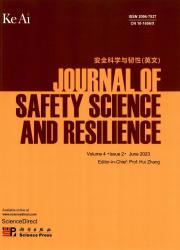Evaluation of the cognitive performance of nuclear power plant operators using heart rate variability under hot-humid exposure
IF 3.4
Q1 PUBLIC, ENVIRONMENTAL & OCCUPATIONAL HEALTH
引用次数: 0
Abstract
When sudden disasters such as earthquakes and tsunamis culminate in the outage of control systems in nuclear power plants, the operators may be exposed to extremely hot-humid environmental conditions while still facing demanding cognitive tasks. To investigate how their cognitive performance is related to their heart rate variability (HRV), we exposed nuclear power plant operators to four high temperature and humidity environments and measured their HRV during seven different cognitive tasks for 30 min. Generalized linear mixed-effects models (GLMMs) are used to analyze the relationship between HRV and operators' cognitive performance. Studies have shown that all indicators of HRV have a significant impact on the cognitive ability of operators. In both the low frequency (LF) and high frequency (HF), especially in the very low frequency (VLF) domain, HRV significantly correlates with the operator's cognition. Although the cognitive performance aggravates slightly within 30 min, increasing the humidity under fixed high temperatures does not exhibit an overall effect on cognitive performance. Henceforth, this study provides a guidance for safety limits of the operator's working duration. Moreover, VLF, LF, and HF domains might be potential physiological indicators to monitor the cognitive ability of operators.
在湿热环境下使用心率变异性评价核电站操作员的认知能力
当地震和海啸等突发灾害最终导致核电站控制系统中断时,操作人员可能会暴露在极端湿热的环境条件下,同时仍然面临苛刻的认知任务。为了研究他们的认知表现与心率变异性(HRV)之间的关系,我们将核电站操作员暴露在4种高温高湿环境中,并在7种不同的认知任务中测量了他们的心率变异性(HRV),时间为30分钟。研究表明,HRV的各项指标对操作人员的认知能力有显著影响。在低频(LF)和高频(HF)领域,特别是在甚低频(VLF)领域,HRV与操作员的认知显著相关。虽然在30min内认知表现略有恶化,但在固定高温下增加湿度对认知表现没有整体影响。因此,本研究为操作人员工作时长安全限值的制定提供了指导。此外,VLF、LF和HF结构域可能是监测操作者认知能力的潜在生理指标。
本文章由计算机程序翻译,如有差异,请以英文原文为准。
求助全文
约1分钟内获得全文
求助全文
来源期刊

安全科学与韧性(英文)
Management Science and Operations Research, Safety, Risk, Reliability and Quality, Safety Research
CiteScore
8.70
自引率
0.00%
发文量
0
审稿时长
72 days
 求助内容:
求助内容: 应助结果提醒方式:
应助结果提醒方式:


